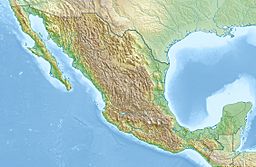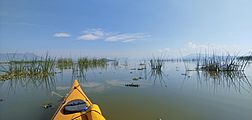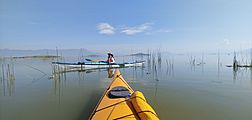Lake Cuitzeo facts for kids
Quick facts for kids Lake CuitzeoLago de Cuitzeo |
|
|---|---|
 |
|
| Location | Michoacán / Guanajuato, Mexico |
| Coordinates | 19°56′0″N 101°5′0″W / 19.93333°N 101.08333°W |
| Primary outflows | a canal which follows the Guanajuato-Michoacan border northward |
| Basin countries | Mexico |
| Max. length | 20 km (12 mi) |
| Max. width | 20 km (12 mi) |
| Surface area | 300–400 km2 (120–150 sq mi) |
| Average depth | .9 m (2 ft 11 in) |
| Surface elevation | 1,830 m (6,000 ft) |
| Islands | 11 |
| Settlements | Cuitzeo de la Laguna Copandaro de Galeana Chucandiro Huandacareo, Iramuco |
Lake Cuitzeo (Spanish: [kwitˈseo]) is a large lake in the central part of Mexico. You can find it in the state of Michoacán. It covers an area of about 300 to 400 square kilometers (115 to 150 square miles). This makes it the second-largest freshwater lake in Mexico.
Lake Cuitzeo is known as an "astatic" lake. This means its water level and how much water it holds change often. Sometimes it's very full, and other times it can be quite shallow.
Contents
Where is Lake Cuitzeo Located?
Lake Cuitzeo sits in a special type of area called an endorheic basin. This means it's like a big bowl where water collects, but it doesn't flow out to the ocean. Imagine a bathtub with no drain! Most of this basin is in Michoacán state. A smaller part is in Guanajuato state.
The city of Morelia, which is the capital of Michoacán, is located south of the lake within this basin. Nearby, you'll find the Lerma River basin to the east and north. To the south are the mountains of the Trans-Mexican Volcanic Belt. The basin of Lake Pátzcuaro is to the west.
Lake Shape and Water Flow
Lake Cuitzeo has an unusual shape. It has northern, western, and eastern parts. These parts are connected by a marshy area in the middle. This central marsh is where most of the fresh water flows into the lake.
The lake doesn't have a natural way for water to flow out. However, a canal was built to the north. This canal helps the lake drain into the Lerma River when the water level gets too high. This keeps the lake's elevation at about 1830 meters (6,000 feet).
A highway was built that divided the western part of the lake into two sections. The westernmost section of the lake is saltier. This part is home to special creatures like clam shrimps and certain types of insects. The lake basin is also the only place where you can find a specific type of garter snake called Thamnophis eques cuitzeoensis. This snake is mostly harmless and lives near water.
Rivers and Farming
Three main rivers flow into Lake Cuitzeo: the Viejo de Morelia, Grande de Morelia, and Querendaro rivers. These rivers start in the mountains to the south. They help water the farms south of the lake. The water then flows into the central part of the lake through irrigation canals. Farmers in this area grow crops like corn, cotton, and coffee.
Nature and Environment
The land around Lake Cuitzeo is a mix of different environments. About 40% of the area is used for farming. Another 15% is pasture land for animals. About 20% is covered by pine-oak forests, which grow at higher elevations. The remaining 15% is tropical dry forest.
The pine-oak forests are part of a larger forest area called the Trans-Mexican Volcanic Belt pine-oak forests. The lower areas around the lake are part of the Bajío dry forests ecoregion. This dry forest area also stretches north into the Lerma River basin.
Fun Activities at Lake Cuitzeo
Lake Cuitzeo is a great place to visit! It has several small islands. Some of these islands have ancient remains from before the Spanish arrived in Mexico. One island was even used as an old cemetery.
If you love birds, this lake is perfect for you. Many different types of birds visit the lake in winter. It's a wonderful spot for bird watching. You can also enjoy kayaking on the southeast shore. There's a good spot for fishermen to enter the lake near the town of San Bernardo. This town is about 13 kilometers (8 miles) west of Morelia's International Airport.
See also
 In Spanish: Lago de Cuitzeo para niños
In Spanish: Lago de Cuitzeo para niños




